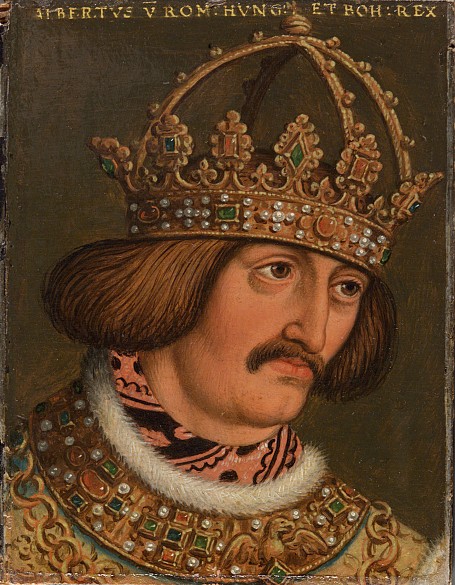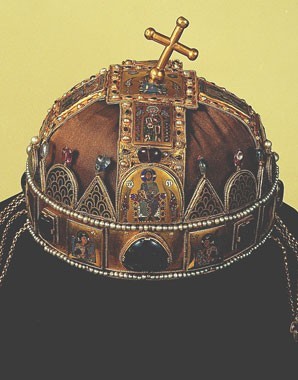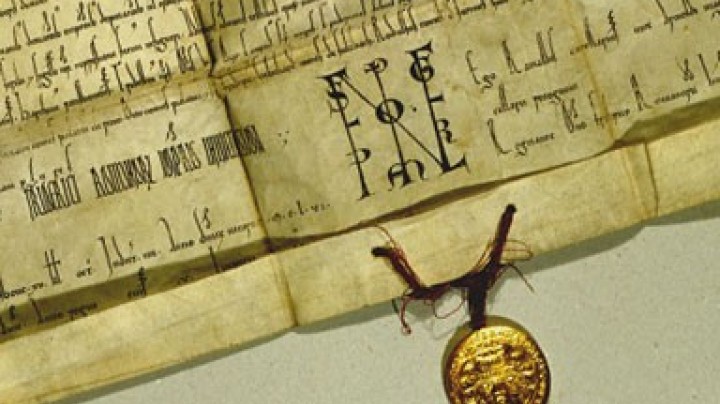Albrecht V: Marriage and offspring
Albrecht left behind his widow Elizabeth (1409–1444), daughter of Emperor Sigismund. This active and resolute woman has gone down in the annals of history above all on account of the hazardous abduction of the Crown of St Stephen.
Since her marriage to Albrecht had resulted only in a son named George (b. 1435) who had died shortly after his birth and two daughters, Anna (b. 1432) and Elizabeth (b. 1436 or 1437), there was no male successor on Albrecht’s death. However, his widow was pregnant when her husband died, which preserved her from a forced marriage to the Polish king Ladislaus Jagiello, as demanded by the Bohemian Estates.
Recognizing that it was futile to insist on the Bohemian royal title, Elizabeth initially concentrated on preserving her claims in Hungary. In order to lay her hands on the symbol of rightful sovereignty, the Hungarian Crown of St Stephen, she sent her lady-in-waiting Helene Kottanerin on a hazardous mission to steal the crown from the royal castle at Visegrád. She was successful, afterwards escaping on a break-neck sleigh journey down the frozen Danube to Komorn (Komárom), where Elizabeth was in labour. There is a legend that the cross on the hoop of the crown was damaged during the journey and has been crooked ever since.
The child born shortly afterwards was a boy, who was baptized Ladislaus and soon given the sobriquet of 'the Posthumous' since he had been born after his father’s death.
His resolute mother had her own ideas about his future. She disregarded the regulation for the regency during the boy’s minority, which should now have fallen to the head of the House, Frederick V from the Leopoldine Habsburg line, who had succeeded Albrecht as king of the Holy Roman Empire. She wanted to entrust her son to Frederick’s younger brother Albrecht VI, who, fired by this support, took up arms against his brother, a conflict that eventually culminated in the siege of Frederick in the Vienna Hofburg.
Not until she came under increasing pressure from the Polish king Ladislaus III did she reconcile herself with Frederick, entrusting her son and two daughters to him as wards and surrendering the Crown of St Stephen to him. The conflict with Ladislaus for Hungary lasted until shortly before her death in 1442.
Named Elizabeth after her mother, the younger daughter (1436 or 1437–1505) was given in marriage by her guardian Frederick to the nephew of her mother’s adversary, Casimir IV of Poland-Lithuania in 1459, a pawn in the policy of rapprochement between the two dynasties.
During the thirty-eight years of her marriage to the Polish king Elizabeth identified fully with his aims. Against the interests of her native Habsburg dynasty she fought with ultimate success to gain the Bohemian and Hungarian crowns for her eldest son Ladislaus (as king of Bohemia Ladislaus II). Held in high regard by her contemporaries, the queen is considered to be one of the most important female figures in Polish history.
Her elder sister Anna (1432–1462) was given in marriage by their guardian Frederick to Duke William III of Saxony. However, after birth of two daughters, he repudiated her and she was incarcerated for the rest of her life in the fortress of Eckartsburg in Thuringia.














